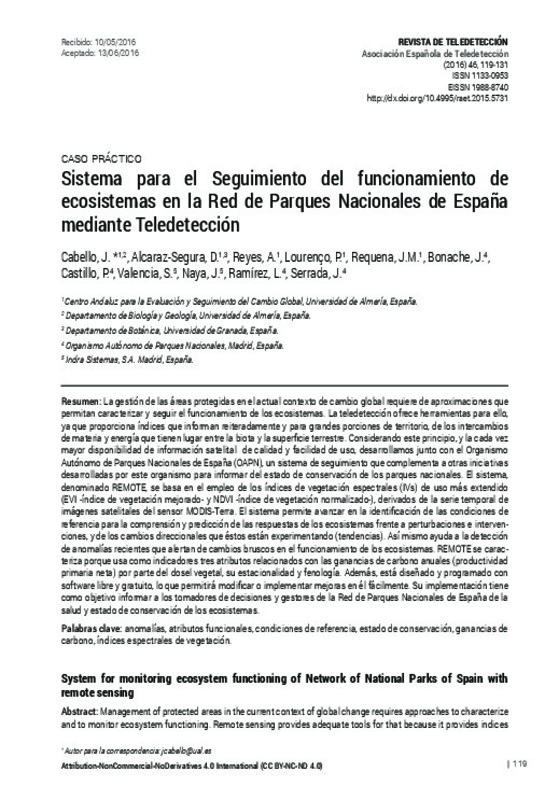|
Resumen:
|
[EN] Management of protected areas in the current context of global change requires approaches to characterize and to monitor ecosystem functioning. Remote sensing provides adequate tools for that because it provides índices ...[+]
[EN] Management of protected areas in the current context of global change requires approaches to characterize and to monitor ecosystem functioning. Remote sensing provides adequate tools for that because it provides índices that inform repeatedly and for large areas of land, about matter and energy exchanges between the biota and land surface. Considering this principle, and the continuous improvements in the availability of satellite data of higher quality and friendly use, we have developed with the Autonomous Organization of National Parks of Spain (OAPN), a monitoring system that complements other monitoring initiatives from this agency to inform about the conservation status of national parks. The system, called REMOTE, is based on the most used spectral vegetation indices on scientific literature, EVI (Enhanced Vegetation Index) and NDVI (Normalized Difference Vegetation Index), derived from the time series of satellite images of the MODIS-Terra sensor. The systems allows to progress in identification of reference conditions to understand and predict ecosystems response against environmental perturbations or management actions, and their directional changes (trends) they are experiencing. Likewise, establishment of reference conditions helps to identify anomalies that warn of sudden changes in ecosystem functioning. The system uses as ecosystem functioning indicators three attributes related to the annual carbon gains (net primary production) by the canopy, their seasonality and phenology. In addittion, Remote has been designed and programmed on open and free software allowing future modifications and improvements in an easy way. The implementation of this system aims to inform decision-makers and managers of the Network of National Parks of Spain about the health and conservation status of ecosystems.
[-]
[ES] La gestión de las áreas protegidas en el actual contexto de cambio global requiere de aproximaciones que permitan caracterizar y seguir el funcionamiento de los ecosistemas. La teledetección ofrece herramientas para ...[+]
[ES] La gestión de las áreas protegidas en el actual contexto de cambio global requiere de aproximaciones que permitan caracterizar y seguir el funcionamiento de los ecosistemas. La teledetección ofrece herramientas para ello, ya que proporciona índices que informan reiteradamente y para grandes porciones de territorio, de los intercambios de materia y energía que tienen lugar entre la biota y la superficie terrestre. Considerando este principio, y la cada vez mayor disponibilidad de información satelital de calidad y facilidad de uso, desarrollamos junto con el Organismo Autónomo de Parques Nacionales de España (OAPN), un sistema de seguimiento que complementa a otras iniciativas desarrolladas por este organismo para informar del estado de conservación de los parques nacionales. El sistema, denominado REMOTE, se basa en el empleo de los índices de vegetación espectrales (IVs) de uso más extendido (EVI -índice de vegetación mejorado- y NDVI -índice de vegetación normalizado-), derivados de la serie temporal de imágenes satelitales del sensor MODIS-Terra. El sistema permite avanzar en la identificación de las condiciones de referencia para la comprensión y predicción de las respuestas de los ecosistemas frente a perturbaciones e interven-ciones, y de los cambios direccionales que éstos están experimentando (tendencias). Así mismo ayuda a la detección de anomalías recientes que alertan de cambios bruscos en el funcionamiento de los ecosistemas. REMOTE se carac-teriza porque usa como indicadores tres atributos relacionados con las ganancias de carbono anuales (productividad primaria neta) por parte del dosel vegetal, su estacionalidad y fenología. Además, está diseñado y programado con software libre y gratuito, lo que permitirá modificar o implementar mejoras en él fácilmente. Su implementación tiene como objetivo informar a los tomadores de decisiones y gestores de la Red de Parques Nacionales de España de la salud y estado de conservación de los ecosistemas.
[-]
|








